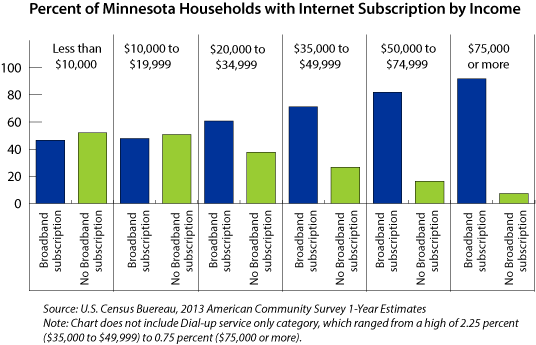by Nick Dobbins
November 2014
The state of Minnesota has set goals, established with Minn. Stat. Sec. 237.012, that all residents will have access to high-speed broadband by 2015 and that Minnesota will be in the top five states for both broadband access and broadband speed. As of October 2013, 74.53 percent of Minnesotans had internet services available to them that met those goals1. Earlier this year the Department of Employment and Economic Development began accepting applications for funding to expand broadband internet infrastructure in Minnesota, on the heels of the launch of a $20 million Border-to-Border Broadband Development Grant Program. The program aims to expand high-speed Internet coverage into parts of the state that currently lack adequate service.
While we don't have the space to explore exactly to what extent access to the Internet helps people educate themselves, find employment, and improve their lives, we can take a quick look at how Minnesota currently stacks up to the rest of the country in terms of how many citizens currently have Internet access in their homes.
As you can see, Minnesota is generally outperforming the national average for Internet access. Only 18 percent of Minnesota households lack Internet access, compared to 22 percent nationwide. However, these data do not speak to what Internet services are available to citizens, but to the services to which they have opted to subscribe. Making high speed Internet available to all Minnesotans is only half the battle. As you can see below, there is also a strong relationship between household income and subscribing to a broadband Internet service which suggests that cost is often a barrier to Internet service for low-income households.
Expanding our capacity for broadband service out into rural and underserved locations, so that all Minnesotans who want and can afford high-speed Internet have access to it will undoubtedly help Minnesota workers going forward. Finding a way to make that service more affordable may help close the access gap that seems to exist between the richer and the poorer Minnesotans.


1Connect Minnesota via The Governor's Task Force on Broadband, 2013 Annual Report, January 21, 2014